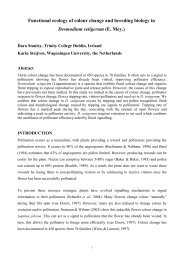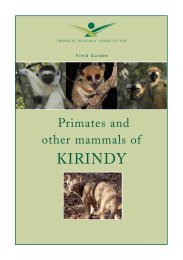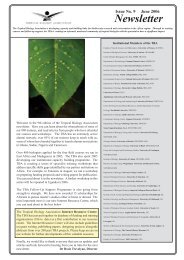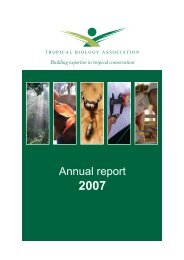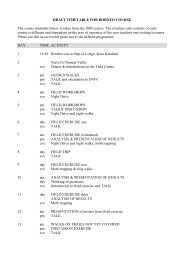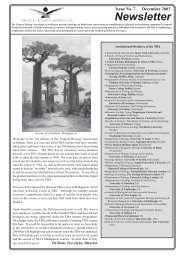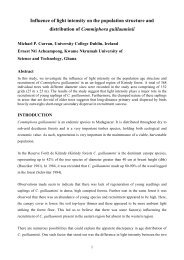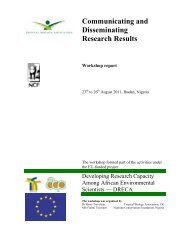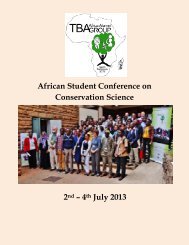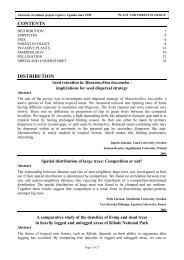Download TAAG Book of Abstracts - Tropical Biology Association
Download TAAG Book of Abstracts - Tropical Biology Association
Download TAAG Book of Abstracts - Tropical Biology Association
You also want an ePaper? Increase the reach of your titles
YUMPU automatically turns print PDFs into web optimized ePapers that Google loves.
Effort towards Conservation <strong>of</strong> Bird Species across<br />
Urban-Rural Gradients in Benin City, Edo State, Nigeria<br />
1 Akemien Neri Nerioya, 2 Abalaka Jacinta, 3 Molokwu<br />
Mary, 2 Nwaogu Josiah Chima<br />
1 Federal college <strong>of</strong> Forestry, Jos, Plateau State, Nigeria<br />
2 A.P. Leventis ornithological Research Institute, Jos,<br />
Plateau, Nigeria<br />
3 Fauna and Flora International, Monrovia, Liberia<br />
Email for Correspondence:akemiennerioya@yahoo.com<br />
Abstract<br />
Urbanization is unquestionably the most ubiquitous<br />
form <strong>of</strong> land transformation that severely affect<br />
biodiversity. In order to ascertain the avian composition<br />
and potentiality <strong>of</strong> biodiversity conservation across an<br />
urban gradient,we surveyed birds across the urban-rual<br />
gradient in Benin City, Edo state, Nigeria. Fourty-five<br />
transects (each 1,601m long) were evenly distributed<br />
across three predefined gradient sites from the urban<br />
core to the rural undeveloped area namely, Vegetation<br />
Exclusive Residence (VER), Vegetation Inclusive<br />
Residence (VIR), Undeveloped site (UND) respectively.<br />
Transects surveys were replicated morning and evening<br />
on different days. A total <strong>of</strong> 16,043 bird individuals from<br />
139 species were recorded. Diversity and abundance<br />
varied significantly across the gradient. Avian diversity<br />
increased across the urban-rural gradient while<br />
abundance decreased across thesame gradient. All the<br />
bird species recorded in the three sites and their<br />
abundance were compiled into a checklist. Residents<br />
were casually interviewed on their knowledge about<br />
birds and conservation-inclined development. Overall,<br />
residents’ perception seem positive towards<br />
conservation <strong>of</strong> birds.We recommend a follow up with<br />
conservation education as a good number <strong>of</strong> the<br />
residents do not appreciate an aspect <strong>of</strong> bird behaviour,<br />
such as birdcalls which they perceive as “bad sign”. In<br />
addition, there is need for conservation inclined<br />
development such as protection <strong>of</strong> the Benin moat<br />
which fragments the VIR and habours a lot <strong>of</strong> vegetation<br />
within the City.<br />
Keywords: Vegetation Exclusive Residence (VER),<br />
Vegetation Inclusive Residence (VIR), Undeveloped site<br />
(UND), Urbanization, urban-rural gradient<br />
Elephant Tolerance to Human activity in the Mara<br />
Ecosystem <strong>of</strong> Kenya<br />
Mayeli Hensley<br />
IAS University <strong>of</strong> Washington Environmental Science<br />
Program<br />
Email for correspondence: may4u2nvme@msn.com<br />
Abstract<br />
The decline and management <strong>of</strong> elephant populations in<br />
Africa is a key concern <strong>of</strong> their conservation. This study<br />
investigated how elephant behaviour is affected by<br />
exposure to human activity. I compared the distribution<br />
<strong>of</strong> elephants after they had been translocated from<br />
Narok-North to the Masai Mara National Reserve<br />
(MMNR) by the Kenya Wildlife Service (KWS) with native<br />
Mara elephants who had not been translocated. It was<br />
expected that the Narok elephant sub-population,<br />
which had experienced high levels <strong>of</strong> negative<br />
interactions with humans, would express less tolerance<br />
to human activity than the native Mara populations,<br />
which experience fewer negative interactions with<br />
humans. I quantified the tendency for elephants to<br />
avoid humans by recording the distance away from<br />
roads and human activity along 20 road transects. A<br />
total <strong>of</strong> 769 elephants in 112 herds were counted. My<br />
results indicated that the Narok-North sub population<br />
had no tolerance to human activity, with no sightings <strong>of</strong><br />
the translocated elephants in any <strong>of</strong> the transects.<br />
Furthermore, GSM/GPS readings from collars on two<br />
translocated matriarchs indicated that they had crossed<br />
to Northern Serengeti National park, which presumably<br />
has lower human activity than MMNR. Taken together,<br />
my results suggest that the trans-located elephants had<br />
decreased tolerance to human activity, likely due to<br />
negative experiences stemming from Human Elephant<br />
Conflict (HEC), which has plagued the Narok area as a<br />
result <strong>of</strong> increased human population and the<br />
conversion <strong>of</strong> elephant range areas into crop farms. It is<br />
recommended that a long-term monitoring program be<br />
established to better document elephant behavioral<br />
characteristics in regard to human activity in the Mara<br />
ecosystem.<br />
Keywords: translocation, species conservation, Masai<br />
Mara, Human Elephant Conflict (HEC).<br />
<strong>TAAG</strong> First African Student’s Conference, Nairobi. 2-4 July, 2013 23




